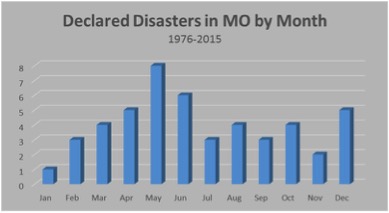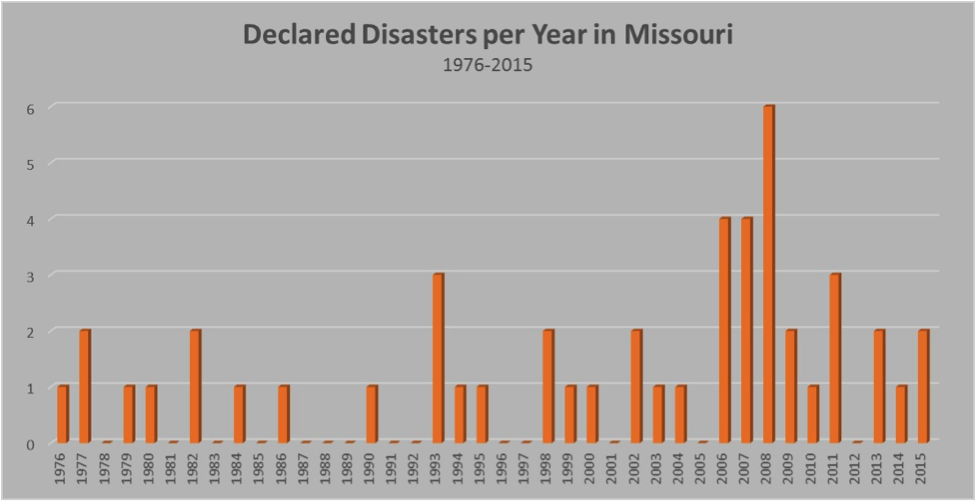 This week is “Severe Weather Awareness Week” in Missouri[1]. Seems odd, in a way, that we’re limiting our awareness of severe weather and what it can do to one week when weather disasters happen throughout the year.
This week is “Severe Weather Awareness Week” in Missouri[1]. Seems odd, in a way, that we’re limiting our awareness of severe weather and what it can do to one week when weather disasters happen throughout the year.
Damage caused by tornado, Joplin, MO – May, 2011 (Eric Thayer, Reuters)
Though our weather is most unstable in the spring – which is probably why Severe Weather Awareness Week is observed this month and not in November – there isn’t a month in the last forty years in which a major storm hasn’t occurred (chart 1).
Chart 1 – Number of Declared Weather Disasters in Missouri, by Month, 1976-2015
(Source: MO Dept. of Public Safety, State Emergency Management Agency)
Some of the last forty years have proved to be considerably riskier, weather-wise, than the average of 1.2 declarations/year over the entire 40-year period (chart 2).
Chart 2 – Declared Weather Disasters per Year in Missouri, 1976-2015
(Source: MO Dept. of Public Safety, State Emergency Management Agency)
Note that disaster declarations due to severe weather have become more frequent in Missouri in the last decade. In fact, there were more weather-related disaster declarations (25) in the last decade than in the three previous decades combined (23). Is this an anomaly or evidence of a growing threat?
As they say in the investment game, past performance is a poor predictor of the future (or in the weather prediction business, there’s no such thing as certainty).
Risk is defined by ISO as “the effect of uncertainty on objectives”. Severe weather poses a great deal of risk, of course. We can’t be certain what will happen next week or next month, let alone what will happen five years down the road, regardless of how much weather modeling is said to be improving. There will always be some degree of uncertainty.
Severe weather is just one example of the many risks your company may face. And while severe weather clearly poses a risk to the health and safety of your employees, it also poses a serious potential risk to your product and process quality.
You could conceivably try to manage every possible risk to your organization – identifying, analyzing, prioritizing, planning, tracking and reporting, controlling, reviewing, and updating – but that’s not what ISO 9001:2015 is asking you to do. What you have to decide is “What are the greatest risks we face here and now?” and “What can we do about them?”
ISO 9001:2015 is designed to incorporate risk-based thinking into any organization’s quality management system.
What can go wrong when, where, how, and why? Whether you intend to have your quality management system certified to the newest version of ISO 9001 or you simply want to run your business more efficiently and effectively, start by identifying your risks.
Need help making sense of your risks? Then, contact me right now!
[1] Severe Weather Awareness Week is March 14-18, 2016. See http://www.weather.gov/lsx/severeweek for detailed information.
Bio:
Stephen M. Flick
Q9C Consulting, LLC
Quality, Environmental, and Health & Safety Auditing
Process Analysis & Improvement
Content Development, Technical Writing, and Presentations
3105 Crystal Lake Dr.
St. Louis, MO 63129 USA
(314) 471-6318
http://q9cqualityconsulting.com
steve@q9cqualityconsulting.com

